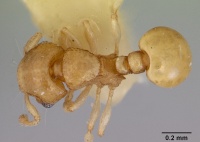Mayriella sharpi
| Mayriella sharpi | |
|---|---|

| |
| Scientific classification | |
| Kingdom: | Animalia |
| Phylum: | Arthropoda |
| Class: | Insecta |
| Order: | Hymenoptera |
| Family: | Formicidae |
| Subfamily: | Myrmicinae |
| Tribe: | Crematogastrini |
| Genus: | Mayriella |
| Species: | M. sharpi |
| Binomial name | |
| Mayriella sharpi Shattuck & Barnett, 2007 | |
The only known collection of this species consists of a single worker found in rainforest. The specimen is pale yellow and appears to be callow.
Identification
M. sharpi is immediately recognizable by the sharply pointed anteroventral extensions of the compound eyes. It is also the only species currently known from Papua New Guinea. The specimen is unusual in having the sting placed forward along the ventral surface of the gaster and directed downward. Given the possibly callow nature of the specimen it is difficult to assess whether this is its normal position or if the gaster has been deformed during preservation in alcohol before being point mounted. Additional specimens will be required to ascertain the true nature of the sting placement. (Shattuck and Barnett 2007)
Distribution
Latitudinal Distribution Pattern
Latitudinal Range: -5.26569° to -9.4°.
| North Temperate |
North Subtropical |
Tropical | South Subtropical |
South Temperate |
- Source: AntMaps
Distribution based on Regional Taxon Lists
Indo-Australian Region: New Guinea.
Distribution based on AntMaps
Distribution based on AntWeb specimens
Check data from AntWeb
Countries Occupied
| Number of countries occupied by this species based on AntWiki Regional Taxon Lists. In general, fewer countries occupied indicates a narrower range, while more countries indicates a more widespread species. |

|
Estimated Abundance
| Relative abundance based on number of AntMaps records per species (this species within the purple bar). Fewer records (to the left) indicates a less abundant/encountered species while more records (to the right) indicates more abundant/encountered species. |

|
Biology
Species of Mayriella show strong preference for moist, forested areas. Most specimens have been collected from rainforest or wet sclerophyll woodlands with relatively few collections from dry sclerophyll or scrub habitats (and these are restricted to Australia). Nests are normally found in soil under stones or with a small mound of loose dirt at the entrance. They have also been found nesting in rotten logs and occasionally arboreally. The number of workers in nests averages between 50 and 100 and about one-half of the nest series containing queens contain more than one, suggesting that species are polygynous. Foraging workers are most commonly collected from litter samples. Nests appear to be locally abundant although patchily distributed on a larger scale. For example, in the Brindabella Ranges near Canberra, ACT, Mayriella ebbei is infrequently encountered and is known from only a few localities. However, near Baroomba Rocks (located on the eastern slope of the Brindabella Ranges) M. ebbei occurs commonly under rocks in an area covering several hundred square meters. This population appears limited to this small area as nests could not be found in areas with similar geography and vegetation located several kilometers away. However, observations are limited and additional data will be required to determine if these habits are widespread and/or occur in other species. Additionally, while Taylor (1961) made similar observations for Mayriella abstinens, these were based on the introduced population found in New Zealand and should be confirmed for naturally occurring populations of the genus. (Shattuck and Barnett 2007)
Castes
Known only from the worker caste.
Nomenclature
The following information is derived from Barry Bolton's Online Catalogue of the Ants of the World.
- sharpi. Mayriella sharpi Shattuck & Barnett, 2007: 447, figs. 17-19 (w.) NEW GUINEA (Papua New Guinea).
- Type-material: holotype worker.
- Type-locality: Papua New Guinea: Central Prov., Bisianumu, nr Sogeri, 15-20.iii.1955 (E.O. Wilson).
- Type-depository: ANIC.
- Distribution: Papua New Guinea.
Unless otherwise noted the text for the remainder of this section is reported from the publication that includes the original description.
Description
Worker
Sculpturing in posterior section of antennal scrobe well developed and distinct; compound eye forming a sharp point ventrally; sculpturing on dorsal mesosoma consisting of small, widely spaced pits; propodeal spines relatively short and thick; dorsal surface of petiole in lateral profile uniformly convex, without distinct dorsal and posterior faces and forming a blunt angle with the anterior face; in dorsal view, postpetiole with the anterior and posterior regions approximately the same width (the region connecting them either flat or weakly convex); postpetiole and gaster lacking erect hairs dorsally.
Measurements. Holotype: CI 1.01; HL 0.45; HTL 0.25; HW 0.46; ML 0.48; PW 0.32; SI 0.63; SL 0.29.
Type Material
- Holotype, worker, Bisianumu, near Sogeri, Central, Papua New Guinea, Wilson,E.O., ANIC32-014459, Australian National Insect Collection.
References
- Shattuck, S.O. & Barnett, N.J. 2007. Revision of the ant genus Mayriella (pp. 437-458). In Snelling, R.R., Fisher, B.L. & Ward, P.S. (eds). Advances in ant systematics: homage to E.O. Wilson – 50 years of contributions. Memoirs of the American Entomological Institute 80:690 pp.
References based on Global Ant Biodiversity Informatics
- CSIRO Collection
- Janda M., G. D. Alpert, M. L. Borowiec, E. P. Economo, P. Klimes, E. Sarnat, and S. O. Shattuck. 2011. Cheklist of ants described and recorded from New Guinea and associated islands. Available on http://www.newguineants.org/. Accessed on 24th Feb. 2011.
- Lucky A., L. E. Alonso, E. Sarnat, and J. Hulr. 2015. Ants and scolytine beetles. In: Richards, S.J. and N. Whitmore (editors) 2015. A rapid biodiversity assessment of Papua New Guinea's Hindenburg Wall region. Wildlife Conservation Society Papua New Guinea Program. Goroka, PNG.
- Shattuck S. O., N. J. Barnett. 2007. Revision of the ant genus Mayriella. Memoirs of the American Entomological Institute 80: 437-458.


